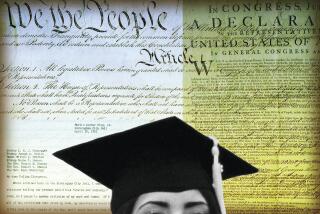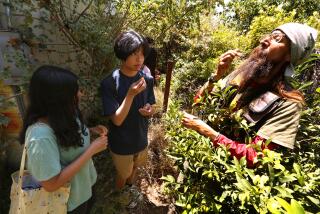Seniors Must Make the Grade in Community Service
- Share via
LONG BEACH — A group of public high school seniors here will soon be among only a few in the country required to perform community service as a condition of graduation.
In a Long Beach Unified School District pilot project beginning in February, about 100 seniors at Millikan, Jordan and Avalon high schools will work with the handicapped, the elderly, the illiterate or help hospitals, health-related organizations and various volunteer groups.
“This is the last chance for a youngster to know that you give something back to the community for what you get,” said Arlene Solomon, a former school board member who is coordinating the program.
Long Beach educators say their program is the first of its kind in the nation because students will be required to perform community work during school hours. The few mandatory community service programs that exist elsewhere, said Long Beach schools spokesman Richard Van Der Laan, are conducted after regular classroom hours.
Van Der Laan said that many Long Beach students have jobs or family situations that make them unable to devote after-school time to such efforts.
If the school board later agrees to expand the program to the district’s other high schools--Wilson, Poly and Lakewood--more than 14,000 students will have to dedicate three school days to developing “a sense of social responsibility,” Solomon said.
Because each senior must take a class in government, those instructors will coordinate community project assignments to match students with the American Red Cross, the American Cancer Society or other charitable organizations.
“We’re interested in a legitimate educational experience and not just busy work,” Van Der Laan said.
Because they have no other school-day program to guide them, Long Beach officials say they may encounter problems getting the students to their off-campus assignments. For now, students will be asked to provide their own transportation.
Officials also are counting on the cooperation of teachers, who may have to postpone exams and help students who miss classes because of the volunteer work, Van Der Laan said.
Sally Migliore, a program associate with the National Society for Internships and Experimental Education in Raleigh, N.C., said she knows of no other public school district in the country that requires students to leave the classroom to do community work. But a growing number of schools are offering voluntary service programs, she said.
“We’re seeing a resurgence of interest (in community work), Migliore said. “I think a part of it is a reaction to the ‘me-ism’ (of the 1970s and ‘80s).”
Elsewhere in the state, Santa Barbara City Schools Supt. Michael McLaughlin has proposed a 60-hour mandatory community service program for his schools. And the county superintendent of schools, William Cirone, is holding a conference in January to explore implementing similar programs in every Santa Barbara school district, according to spokeswoman Wendy Shelton.
At South Pasadena High School, this year’s graduating class is the second to complete a 45-hour after-school community service requirement, Vice Principal Jack Smith said. In Pasadena, school officials will begin a voluntary program in February, said Sharon Thralls, who volunteers as the district’s community services director.
In Los Angeles high schools, about 6,000 students volunteered last year in the school district’s Youth Community Service program, said Cathryn Berger Kaye of the Constitutional Rights Foundation, a nonprofit organization dedicated to promoting citizenship. The voluntary program, nearly 5 years old, often attracts the marginal or lower-income student who does not belong to school clubs, she said.
An Enormous Task
The Los Angeles Unified School District has been exploring a mandatory program “as a possibility,” Kaye said. But implementing such a program in the largest school district in the country would be an “enormous” task, she continued.
Community service assignments may expose students to careers they have never considered, said Solomon, who added that the program is also being offered to counter the “me-first” attitude seen in many young people of the 1970s and ‘80s.
Avalon Principal Jon C. Meyer, who plans to take his entire 30-member senior class together on outdoor projects that emphasize conservation of Santa Catalina Island, said, “I don’t think there’s anything wrong in saying, ‘Look, kids, for 20 hours let’s get you away from the television. . . . ‘ “
“It’s not a lot to ask to spend a few hours doing something for your community,” said Avalon senior Don Moritz. Besides, he added, “it’ll get us out of school and into the outdoors.”
More to Read
Sign up for Essential California
The most important California stories and recommendations in your inbox every morning.
You may occasionally receive promotional content from the Los Angeles Times.










